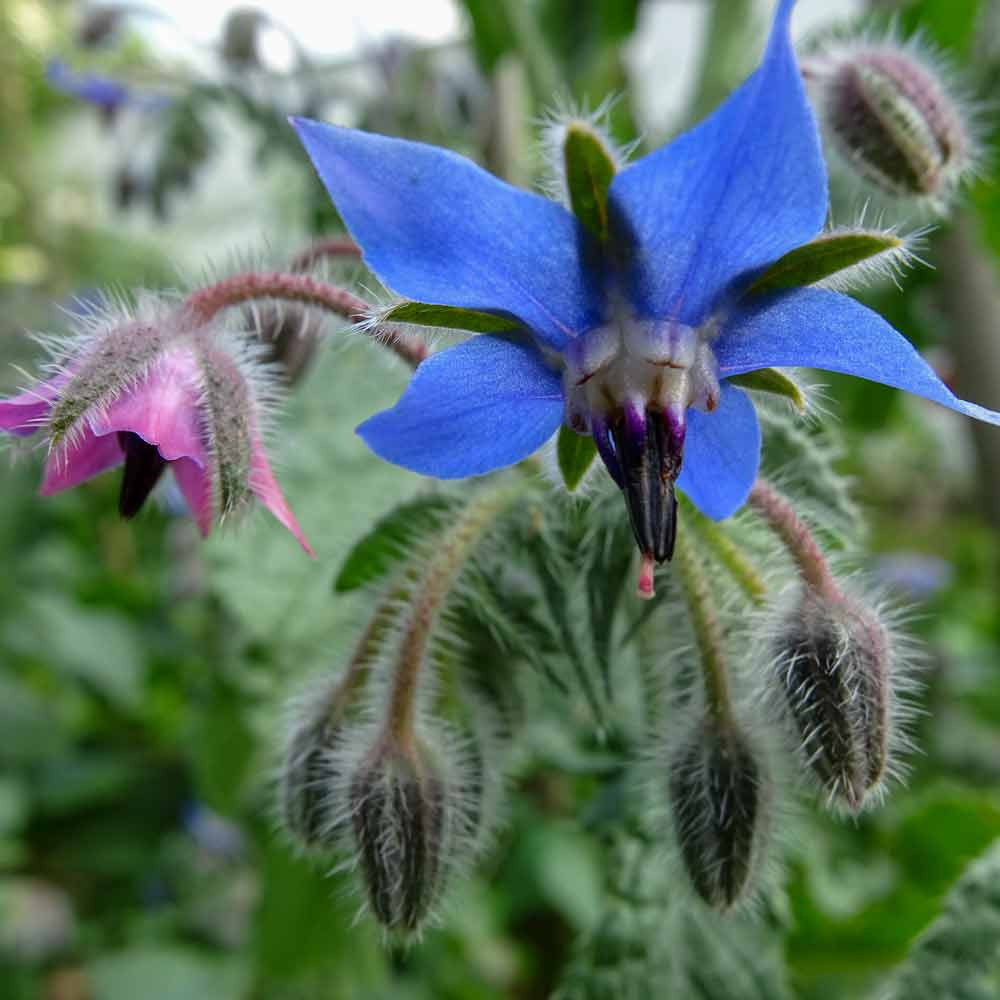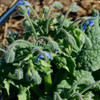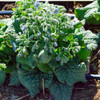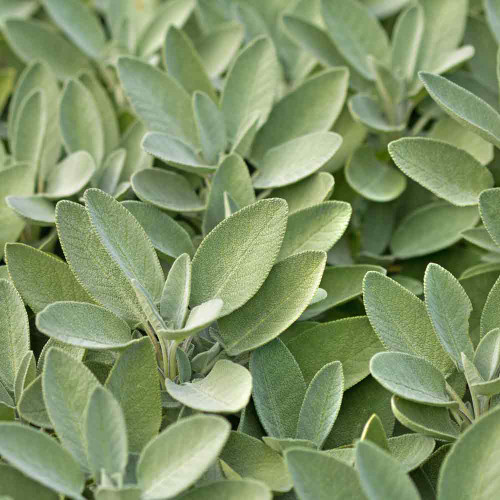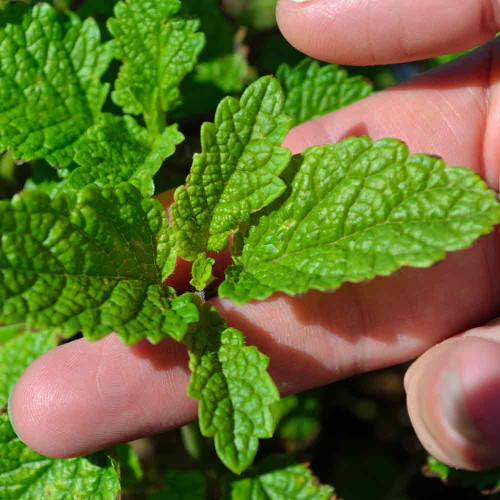Description
Borage - Blue Beauties Always in Bloom
The star-like, sky-blue flowers catch your eye, adding unique beauty to your garden. Look closer, and you'll discover its true value extends far beyond its looks. Think of Borage as a welcoming beacon in your garden ecosystem, effortlessly sending out an irresistible invitation to beneficial life. Soon, its nectar-rich blooms are buzzing, drawing countless bees – honey bees, bumblebees, and tiny native bees – crucial for nearby fruit set, and providing vital nectar for visiting butterflies, especially Monarchs fueling their migrations. At the same time, it draws in an army of tiny beneficial predators: lacewings and hoverflies whose larvae devour aphids, building your garden's natural defenses. It's a simple, beautiful way to actively boost your garden's biodiversity and resilience – free pollination and pest control services, just by planting a patch of blue!
Details
Borage is a versatile herb that is cherished by gardeners for its brilliant blue flowers, its culinary utility marked by a distinctive cucumber-like flavor, and its notable ease of cultivation. The aroma, particularly when the leaves or stems are crushed, is that of fresh cucumber. It grows as a bushy, spreading annual, though it often reappears yearly thanks to its prolific self-seeding habit. Expect plants to reach 1 to 3 feet tall and spread 1 to 2 feet wide, sometimes becoming a bit sprawling.
The leaves are alternate, simple, oval to lance-shaped, up to 6 inches long, with a distinct wrinkled texture and gray-green hue. Both leaves and stems are covered in coarse, bristly hairs shining like mist in sunlight (Note: Gloves may be helpful for sensitive skin during handling). The most captivating feature is the clusters of nodding, star-shaped flowers. Usually a brilliant sky-blue (though intensity may deepen in poorer soils), each bloom has five pointed petals surrounding a prominent dark central cone of stamens. The flowers are relatively small, generally less than 1 inch across. Borage performs well as an annual across USDA Zones 2-11.
Beyond the ubiquitous "Borage," it is frequently called "Starflower," referring to its bloom shape. Its strong attraction to bees earned it names like "Bee Bread," "Bee Bush," and "Bee Plant".
History
With roots reaching back millennia to the Mediterranean basin, potentially originating near Syria or Asia Minor, Borage is an herb with a truly ancient lineage. Its journey across continents began early; historical pathways suggest cultivation spread throughout Europe possibly via the Romans, and later through Arab influence into Spain during the Middle Ages. By the 17th century, it was well-established in gardens across Central Europe and England. Its remarkable ease of growth and tendency to self-seed eventually led to its naturalization in many temperate regions, including North America.
Beyond its physical journey, Borage carried a remarkable reputation through European history, strongly associated with lifting spirits and inspiring courage. Ancient writers like Pliny and Dioscorides linked it to gladness, perhaps even connecting it to the mythical Greek 'nepenthe' known to banish sorrow. This belief solidified through the Middle Ages, earning Borage the popular name "Herb of Courage." Folklore tells of its star-like flowers decorating departing Crusaders or being slipped into drinks to give men the nerve to propose marriage! The sentiment was perfectly captured centuries later by 16th-century herbalist John Gerard's famous quote: "I, Borage, bring always courage."
Carried across the Atlantic, likely along with European settlers bringing cherished herbs to new lands, Borage found fertile ground in North America. Its inherent adaptability and easy self-seeding nature allowed it to naturalize readily in many temperate regions over time. Today, while perhaps less known for its legendary ability to bestow courage, this useful herb remains a beloved fixture in countless gardens across the continent. Modern gardeners value it anew for the same core qualities appreciated for centuries: its striking blue flowers, ease of growth, and especially its powerful ability to draw essential pollinators into the garden ecosystem.
Uses
Borage offers significant value for home gardeners. The star-shaped flowers add unique beauty to herb gardens, cottage gardens, and borders, and can be used fresh in arrangements. Its primary garden role today, however, is often as an exceptional attractant for pollinators and beneficial insects. The nectar-rich blue flowers are irresistible to honey bees, bumblebees, and native bees (earning it the name "Bee Bush"), as well as butterflies and occasionally hummingbirds. Furthermore, the plant provides valuable habitat and resources for predatory insects like lacewings, hoverflies, parasitic wasps, and ladybugs, contributing significantly to biodiversity and natural pest management in the home garden. Borage honey, derived from its nectar, is known for being light and delicate. Additionally, borage acts as a dynamic accumulator, drawing minerals like potassium and calcium from deeper soil layers. When the plant finishes its cycle and decomposes, this nutrient-rich biomass breaks down readily, enriching your compost heap or garden beds for future plantings.
Edible uses focuse on the fresh cucumber-like flavor of the young leaves and the subtle sweetness of the flowers. Select only young, tender leaves to minimize the fuzzy texture; chopping them finely allows their cool flavor to enhance salads, dips, sandwiches, or summer drinks. Flowers offer a hint of sweet, honey-like flavor; their star shape and blue color make beautiful garnishes for salads, desserts, cakes, cold soups, or frozen into ice cubes. They can be candied or steeped into pleasant teas (like traditional Persian gol gâvzabân). Leaves should be eaten in moderation.
The flowers are best showcased fresh but can be cooked into jellies or jams with the leaves, stirred into sauces, or used to flavor pickle brine. Borage pairs well with herbs like dill, mint, and parsley; citrus; cucumbers; tomatoes; peas; bell peppers; and spinach.
Companion Planting
Borage is highly regarded as a companion plant, primarily due to its unparalleled ability to attract pollinators, which benefits nearby crops like squash, strawberries, and tomatoes needing insect pollination. It also draws in beneficial predatory insects that help manage pests throughout the garden. Its positive impact on beneficial insect populations is widely observed.
Planting and Growing Tips
Borage generally prefers temperate conditions but shows considerable adaptability. It performs well in cool weather and is often considered a warm-season annual in temperate zones. In regions with very hot summers (like USDA zones 9-10), it may perform better when planted in fall for winter/spring bloom. This adaptable annual thrives in full sun (6+ hours preferred) but tolerates partial shade. While it grows even in poor soil, providing moderately fertile, well-drained soil encourages lusher growth. The plant is quite drought-tolerant once established thanks to its deep taproot, but consistent moisture produces better foliage and flowering.
Renowned for its ease of growth, direct sowing seeds into the garden after the last frost is the recommended method, as its taproot dislikes transplanting. Sow seeds shallowly, about ¼ to ½ inch deep, spacing plants or thinning seedlings to stand 12 to 24 inches apart for their bushy growth and good air circulation. Germination is usually reliable within 5-8 days in soil temperatures around 60-70°F. Keep the area around young plants weed-free. Water well until established, then water deeply when the top inch or two of soil dries. It rarely needs supplemental fertilizer; excess feeding can lead to leggy growth with fewer flowers. Mulching helps conserve moisture and reduce weeds (keep away from stem base). To manage its prolific self-seeding and encourage more blooms, deadhead spent flowers regularly. Taller plants may benefit from light staking.
For container growing, Borage adapts well, due to its substantial taproot, choose a deep pot (at least 12 inches deep and wide) with excellent drainage. Use a quality potting mix. Plant seeds directly or transplant seedlings very carefully. Check moisture frequently and water thoroughly when the top feels dry. Fertilize container plants sparingly, if at all.
Harvesting Tips
Harvest borage for culinary use when parts are at their best quality. Pick leaves when they are young and tender, before they become overly large and coarse; snip individual leaves or tender stem tips with scissors. Harvest flowers just as they fully open, typically in the morning. Both leaves and flowers have the best flavor when used fresh; leaves lose their cucumber essence upon drying, though flowers can be dried for tea or decoration. For a continuous supply, harvest regularly – this also acts as deadheading, encouraging more production. Remember to wear gloves if sensitive to the leaf/stem hairs.
Learn More
From the soil to the seed to the food you eat - we'll help you grow your best garden!

